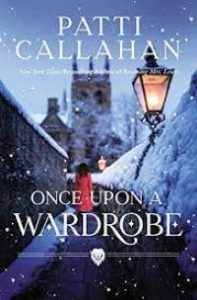By Patti Callahan Henry
Authors spend so much time focusing on plot, character, theme, and dialogue that they may inadvertently give short shrift to setting. It might be woefully underutilized, dismissed as a mere backdrop to the plot, the pretty frills of the story’s dress.
But ignore setting at your story’s peril. Here is the rich soil from which your story grows, the garden where your characters frolic while hearing thematic echoes.
Sometimes setting is described as another character, and yes, it can be looked at it that way, but it can be taken much further. Meaning can be embedded in your setting. Here is a language of images.
When I was writing Surviving Savannah—a story set in both historical 1838 Savannah and modern-day Savannah—the land in both periods needed to echo the mysteries of the two stories. The deep-rooted mythological origins of this place would of course affect the present-day story. I wanted Savannah old and new to mirror each other. And that meant more than just describing a tree or a river. It meant rendering my character’s response to the tree or the river.
In my novel The Favorite Daughter, a character says, “Landscape is memory and memory is landscape.” Think about your own life. When you visit somewhere familiar—a place where your childhood unfolded, for example—memories and emotions rush at you as you pass the elementary school you attended or your old home.
Naturally, it would be the same for your characters. Ask yourself “How is the landscape affecting my character’s thoughts, their memories, and subsequent decisions?”
Here are a few items in my toolbox to optimize your novel’s setting.
1. Immerse Yourself
After choosing my book’s setting, I read books of all sorts on the area, even learning about the local flora and fauna. Among so many other facts, I want to know how hot are the summers, and how much snow falls in January. If at all possible, I visit where my plot happens, strolling the streets where my characters walk and woods where they dwell.
When I was writing Becoming Mrs. Lewis, I planned a wonderful trip to London and Oxford that I dubbed “In the steps of Joy.” I visited everywhere that my character Joy went. At each stop, I’d ask: How would Joy react when seeing this house for the first time? How would she feel as she walked into this pub?
And then there’s always Google Maps’ Streetview, where you can tour areas as if you were there. Do whatever you can. The goal is to find out as much as possible about the location where your story occurs.
2. Accentuate the unique
Think of it this way: if you moved your story somewhere else, would it be the same story? Why or why not? How does your current setting add to the plot? And now that you’re thinking this way, how can those plot-enriching elements of this setting be further accentuated? What others might be added?
Setting should be so important to your story that it couldn’t be set somewhere else.
In Once Upon a Wardrobe, I wanted readers to feel a bit of magic, to experience the unseen influencing the seen. Oxford was my setting, that was clear, but burying this story under a layer of clear sparkling snow, then snuggling beside toasty firesides as it was told—that just seemed right to me.
- Explore myth and archetype
You might dip into books like Bulfinch’s Mythology or Joseph Campbell’s The Power of Myth. Consider the classic themes of your story and what elements of nature might underscore them.
Seek out imagery that echoes those themes, or perhaps your characters’ dilemmas. For example, rivers and water may represent the unconscious. What might a dive into this particular river signify? And dense woodlands sometimes whisper of mystery, danger, and the unknown. Mountaintops can represent triumph or hopefulness.
4. Make a map
Whether your setting exists in this world or your imagination, map it out. I print maps and highlight the routes my character might walk or travel. By doing this, I can later show my reader what my character is passing and seeing. In Once Upon a Wardrobe, bombed-out neighborhoods in London clearly illustrate a period of terrible destruction. They also herald vast changes in the lives of the book’s young characters.
5. Writer, edit thyself
It may be crucial to incorporate incredible history, fantastic fashion, pulsing music, and colorful culture in various forms into your story, but all those marvelous things also must not interrupt or even slow it don. Nothing included should feel digressive or like an info dump.
Yes, I tumble down historical rabbit holes, get obsessed with this fascinating historical tidbit or that amazing coincidence, but then I must ask myself: “Does this piece of information serve my overall story?” Does it contribute to or forward the plot somehow? If it does, it stays. If I just love it because it’s fascinating—or if it just proves I did my research—it goes!
We’d love to hear how you’re using setting in your latest writing project. Let us know on Facebook.

 Patti Callahan Henry is a New York Times and USA Today bestselling author of sixteen novels and podcast host. She is the recipient of The Christy Award 2019 Winner “Book of the Year”; The Harper Lee Distinguished Writer of the Year for 2020 and the Alabama Library Association Book of the Year for 2019. She is the co-host and co-creator of the popular weekly online Friends and Fiction live web show and podcast. Patti is also a contributor to the monthly life lesson essay column for Parade Magazine. A full-time author and mother of three children, she resides in Mountain Brook, Alabama with her husband.
Patti Callahan Henry is a New York Times and USA Today bestselling author of sixteen novels and podcast host. She is the recipient of The Christy Award 2019 Winner “Book of the Year”; The Harper Lee Distinguished Writer of the Year for 2020 and the Alabama Library Association Book of the Year for 2019. She is the co-host and co-creator of the popular weekly online Friends and Fiction live web show and podcast. Patti is also a contributor to the monthly life lesson essay column for Parade Magazine. A full-time author and mother of three children, she resides in Mountain Brook, Alabama with her husband.





